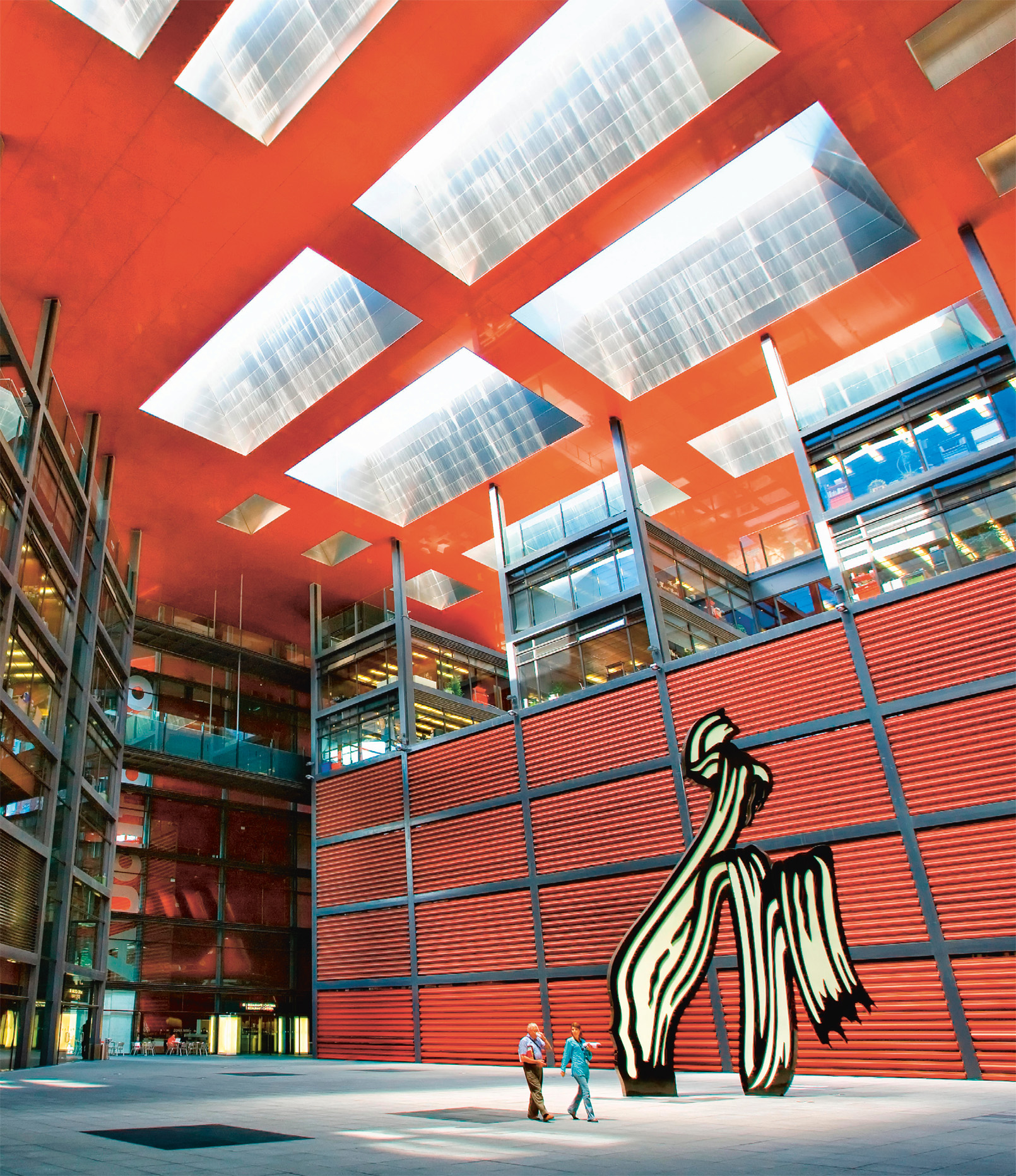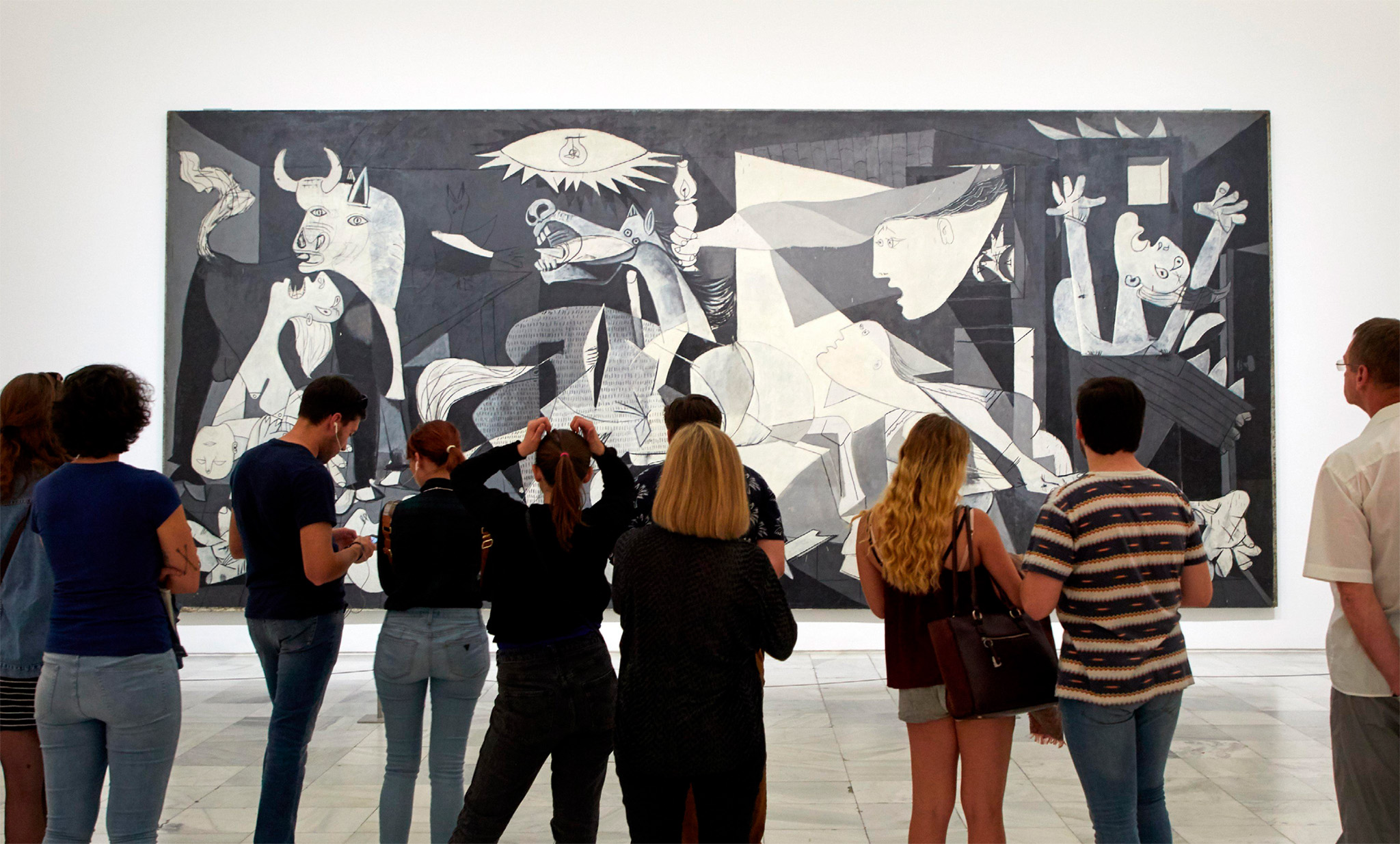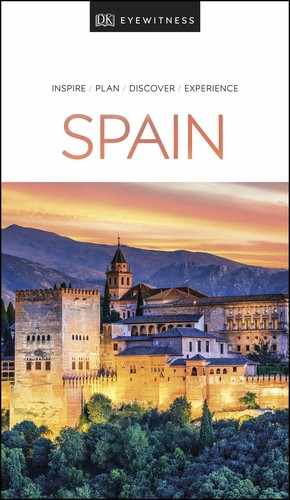g East Madrid g Contents
Perhaps most famous for Picasso’s Guernica, this museum of 20th-century art holds other major works by influential artists, including pieces by Miró and Dalí. The museum has been at the cutting-edge since it opened in 1992 and continues to reinvent itself.

t Green-Blue by Gerhard Richter and Untitled by Bruce Nauman.
Experience East Madrid

t Roy Lichtenstein’s Brushstroke in Nouvel’s extension
Housed in Madrid’s former General Hospital, the museum’s collection is as exciting and impressive as its building. Built in the late 18th century and designed by José de Hermosilla and Francisco Sabatini, the hospital was shut down in 1965, but survived demolition as it was declared a national monument in 1977 due to its history and unique architecture. Restoration of the building began under the direction of Antonio Fernández Alba, and in April 1986 the Reina Sofía Art Centre opened. The distinct steel and glass elevator towers, designed by Spanish architects José Luis Iñiguez de Onzoño and Antonio Vázquez de Castro in collaboration with British architect Ian Ritchie, were added in 1988. The collection was finally inaugurated as a permanent collection – now commonly referred to as simply the Museo Reina Sofía – in 1992. The latest major extension, designed by Jean Nouvel, was added in 2005. Named after its architect, this stunning building increased the museum’s exhibition space and includes Collection 3: From Revolt to Postmodernity, a library, a café and auditoriums which host various events such as film screenings and concerts.
Did You Know?
Jean Nouvel was awarded the Pritzker Prize, architecture's highest honour, in 2008.

Insider Tip
Free Time
Entry to the museum is free after 7pm everyday apart from Tuesday and Sunday. If you’d rather take your time, visit after 1:30pm on Sunday, when you'll have the whole afternoon to explore.
Exploring the Collection

t A crowd gathering in front of Picasso’s spectacular Guernica
The 20th century has undoubtedly been the most brilliant period in the history of Spanish art since the Golden Age of the 17th century. Many facets of the Spanish artistic genius are on show in the Museo Reina Sofía. Sculpture, paintings and even work by the Surrealist film-maker Luis Buñuel provide a skilfully arranged tour through an eventful century. The permanent collection, in the Sabatini Building, is arranged around an open courtyard. Collection 1, on the second floor, displays works dating from 1900 to 1945, and includes rooms dedicated to important movements such as Cubism and Surrealism; Collection 2, on the fourth floor, has works dating from 1945 to 1968, including representatives of Pop Art, Minimalism and more recent tendencies. Collection 3: From Revolt to Postmodernity is dedicated to art from the 1960s to the 1980s.
Did You Know?
The museum is named after Queen Sofía of Spain, mother of the current King Felipe VI.
Picasso’s Guernica
The most well-known single work of the 20th century, this Civil War protest painting was commissioned by the Spanish Republican government in 1937 for a Paris exhibition. Picasso found his inspiration in the mass air attack of the same year on the Basque town of Gernika-Lumo, by German pilots flying for the Nationalist air force. The painting hung in a New York gallery until 1981, reflecting the artist’s wish that it should not return to Spain until democracy was re-established. It was moved here from the Prado in 1992.
EXPERIENCE East Madrid
The Collection |

The Beginnings of Modern Spanish ArtFollowing the storm of creativity that culminated with Goya in the 19th century, Spanish painting went through an unremarkable period. A few artists managed to break the mould, hinting at the dawn of a new era of artistic brilliance; the museum displays the brooding works of Gutiérrez Solana, whose favourite subjects are the people of his native Madrid. Influenced by the Spanish masters, his paintings include La Tertulia del Café de Pombo (1920). |
Pablo PicassoThe works on display span five decades in the life of Pablo Picasso.The first image visitors notice is the haunting Woman in Blue (1901), one of Picasso’s earliest works from his so-called “blue” period. In Room 206 is the most-visited piece in the collection – the vast Guernica (1937). Aside from its unquestionable artistic merits, the canvas has a deep historical significance for Spaniards. |
Miró, Dalí and the SurrealistsJoan Miró turned his hand to many styles. His Surrealist experiments of the 1920s provide evidence of his love of the vivid colours and bold shapes of Catalan folk art. His fellow Catalan, Salvador Dalí, is especially well known as a member of the Surrealist movement, which depended on access to subconscious images without censorship by the rational mind. Other prominent Surrealists whose work is displayed here include Benjamín Palencia, Oscar Domínguez and Luis Buñuel. Dalí’s Surrealist masterpiece, The Great Masturbator (1929), hangs in contrast to the realistic Girl at the Window (1925). Like many of his contemporaries, Dalí embraced widely differing styles during his career. |

Julio GonzálezA friend and contemporary of Gargallo and Picasso, Julio González is known as the father of modern Spanish sculpture, chiefly because of his pioneering use of iron as a raw material. Look out for González’ humorous self-portrait entitled Tête dite “Lapin”, or Head called “Rabbit” (1930). |
The Paris SchoolThe turbulent history of Spain in the 20th century resulted in a steady stream of talented Spanish artists leaving their native land. Many of them, including Picasso, Dalí, Juan Gris and Miró, passed through Paris – some staying for a few months, others for years. Artists of other nationalities also congregated in the French capital, and all of these artists were part of the Paris School. It is possible to see the mutual influence of this closely knit, yet constantly evolving, group of young artists. |
Franco and BeyondThe Civil War (1936–9) had an enormous effect on the development of Spanish art. Under Franco, the state enforced rigid censorship. In the rooms of the fourth floor, the Museo Reina Sofía displays pieces of modern art from the 20th century. Works span the period from the end of World War II in 1945 through to 1968, and the development of different movements is marked. Artists on show include Robert Delaunay, Max Ernst, Francis Bacon and Georges Braque. Later works by Picasso and Míro can also be found here, as can pieces by sculptors Julio López-Hernández and Jorge Oteiza. |
